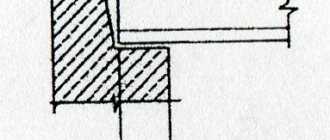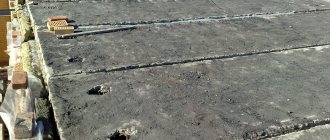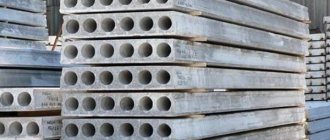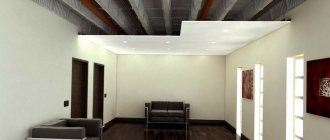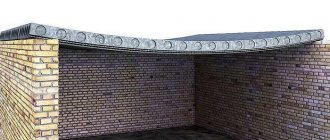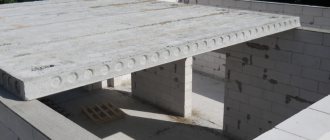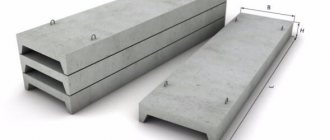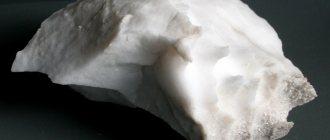Is it possible to lay floor slabs on a gas block?
A floor slab (SP) is a horizontal structure that separates different levels of a building. Ceilings are not only interfloor, but also attic, basement, and attic. Structural calculations are performed at the design stage. During the calculation, strength, stiffness, and crack opening are determined. When making calculations, engineers are guided by STO 501-52-01-2007.
You can use concrete PP when building a house from aerated block if certain requirements are met:
Use of lightweight slabs. To separate floors, standard floors are used, manufactured in accordance with GOST 26434-2015, of the following types:
- 1P - 120 mm thick;
- 1 PC - 220 mm thick with 160 mm round holes.
Floor slabs are not used on aerated concrete blocks marked 2P and 2PK, since they are made of heavy concrete.
Sufficient wall thickness. The minimum thickness of an aerated concrete wall for floor slabs depends on the brand of aerated concrete block. For D500 blocks with a strength class of at least B2.5, this figure is:
- for interfloor ceilings - 300 mm;
- for attics or attics - 200 mm.
The depth of support for the PP must be at least 120 mm.
The presence of an armored belt. Safe support of the slab on a wall made of aerated concrete is only possible with an armored belt made of monolithic concrete. The armored belt promotes uniform distribution of the load created by the slabs on the gas-block walls. The height of the armored belt is 20 cm. It is permissible to lay the armored belt from prefabricated reinforced concrete products, for example U-blocks.
If at least one of these overlap conditions is not met, the gas block is squeezed out of the wall. As a result, cracks appear in the masonry and the structure of aerated concrete is disrupted. In serious cases, the house becomes dangerous to live in, and there is a danger of the load-bearing walls collapsing. But even if the walls do not collapse, it will be uncomfortable to live in such a house: cracks are bridges of cold, so the walls will begin to freeze.
Floor slab installation technology
For installation you need:
- round hollow-core reinforced concrete slabs;
- truck crane;
- cement mortar (cement, water, sand);
- Master OK;
- grinder or autogen;
- sledgehammers;
- level;
- scrap;
- steel brush;
- tow;
- gypsum mortar;
- lime-gypsum mortar;
- thermal insulation material;
- welding machine.
This is not to say that installing floor slabs is an easy process; on the contrary, it is considered quite labor-intensive and risky.
Any foundation is not level and smooth, therefore, before installing reinforced concrete floor slabs, it would be correct and advisable to make the foundation level, for example, lay a brick row on a concrete base. You can check how smooth the surface is using a level. Floor slabs can only be laid on the most flat surface possible; the future service life of the entire building depends on this.
It is necessary to take care of the strength of the foundation, because due to heaving of the soil, its deformation can occur, and regardless of how responsibly the builders approach the installation and how they lay the floor slabs, the building will sag over time.
The foundation can be secured with a regular reinforced mesh, onto which concrete mortar is subsequently applied and floor slabs are installed. The cement must be at least grade 100. The height of the cement layer must be at least 20 cm.
Before installing reinforced concrete floor slabs, you need to prepare them.
If there are flaws, protrusions or chips on the surface, they must be eliminated.
To understand how to lay slabs, before installing and assembling reinforced concrete floor structures, you need to calculate the width so that they occupy the entire perimeter and there are no uncovered parts left. The calculation scheme is quite simple.
Before the installation process, a concrete mixture base is laid out. Laying floor slabs is only possible with the help of a truck crane, since their weight is quite large. Having hooked the reinforced concrete slabs onto the hinges, they are lifted and placed in the right place. Moreover, it will not be possible to carry out installation alone; this process requires a team of 3-5 people. When installing, you need to ensure that each slab lies flat, all elements should be as close to each other as possible. Due to the fact that the cement footing does not harden immediately, the slabs will still be mobile for some time, and installation inaccuracies can be corrected by straightening them with a crowbar.
Floor slabs should only be laid on the main walls of the future premises. Installation of internal partitions and walls is carried out after installing the floor slabs, and they should rest 12 cm on the wall. Adjacent slabs must be secured to each other with mounting loops. For installation, it is better to use a cement-sand mortar; it must be liquid, the sand must be thoroughly sifted, otherwise even if small debris gets in, it can lead to deformation of the floor and ceiling.
After the floor slabs have been installed, there are seams between them that must be sealed. All seams must be cleaned using a steel brush. The gaps between the elements of the reinforced concrete structure are filled with tow, previously soaked in gypsum mortar. The tow layer must be compacted. When the gypsum mixture dries, its volume increases, thus, the tow will be pressed against the walls as much as possible. After this, the cracks are covered with lime-gypsum mortar.
The existing ends also need to be sealed so that the slabs do not freeze during the cold season.
To do this, you can use mineral wool, concrete mortar or backfill brick.
In any construction process, force majeure situations may arise, for example, slabs may burst if unloading rules are violated or they were stored incorrectly.
But it is not advisable to throw away such expensive building material. They can be installed on 3 main walls. Or use them to install the attic space, in this place the load is minimal.
Return to contents
How to make a seam between aerated concrete and a floor slab
The mating of walls made of aerated blocks with PP is carried out taking into account the following rules:
- Hollow core slabs must be laid on a layer of cement-sand mortar. The thickness of the mortar layer must provide the specified support depth.
- A void 140 mm thick is left from the end of the PP to the gas block wall, which is filled with insulation and covered with an airtight material. Thus, an effective damping seam is obtained, compensating for temperature and sedimentary shrinkage. Rigid mineral wool is used as insulation.
- To prevent chipping and uniformly distribute loads in places where the PP is supported, it is recommended to lay reinforcing mesh in the seams of aerated concrete masonry. Reinforcement is performed at the stage of laying the walls. When installing floors, the reinforcement of the slabs is connected to the reinforcement of the wall using metal brackets.
- The remaining seams and voids between the PP and aerated concrete load-bearing walls and interior partitions are filled with cement-sand mortar M35. Polyurethane foam can be used to fill small voids.
Installation of floor slabs on aerated concrete
Scheme for installing slab floors on aerated concrete blocks:
In the diagram: 1 - metal anchor bracket, 2 - floor slab, 3 - masonry made of aerated blocks, 4 - additional block in the masonry, 5 - M35 mortar, 6 - masonry joints.
Step-by-step instructions: how to lay slabs on aerated concrete:
- During the process of laying aerated concrete walls, the masonry is reinforced at a distance of 20-50 cm from the future ceiling.
- A monolithic armored belt made of M200-M300 concrete is poured on top of the finished wall.
- Hollow-core PPs are laid on the reinforced belt, the size of which is established by the project.
- Damping joints are made between the slabs and the wall and the voids are filled.
The laid interfloor ceilings are insulated using lightweight thermal insulation materials and insulated. The walls of the second floor are laid on the floors as follows: the first row of blocks is laid out with mortar, the next rows with glue. Similarly, you can put overlapping structures for the attic floor, residential basement, basement.
Armobelt in openings
Creating an armored belt over openings has some minor features. In this case, the support of the slab will be incomplete, since the ceiling hangs over the void. To support the slab, pillars with lintels in the form of beams are erected.
Pillars can be erected using bricks and blocks. Each pillar is laid out in one and a half bricks.
Reinforced concrete lintels are erected between the pillars. The height of the beams should be 1/20 of the length of the opening. If the distance between the pillars is 2 m, then the height of the beams will be 0.1 m. The width of the beams will be determined by the height from the ratio 0.1 m = 5/7. If the distance between the supports is 2 m, and the height of the beams is 0.1 m, then the width of the reinforced concrete beams is 0.07 m. To fill the beams, removable formwork made of boards is used.
Based on the material used, the slabs are divided into:
- reinforced concrete;
- aerated concrete.
Materials, tools and special equipment for laying slabs
Installation of floor slabs on aerated concrete blocks is the most labor-intensive stage of building a house made of aerated concrete. If the PP between the ground level and the first floor can be installed by several people, then to supply products to the level of the second floor, the use of special lifting equipment will be required, because even the smallest tiles weigh from 350 kg. To reduce the cost of renting special equipment, you need to prepare the construction site:
- purchase metal anchors, insulation, waterproofing and components for cement-sand mortar;
- clear a parking area for lifting equipment;
- Unload the slabs so that it is convenient to carry out slinging.
If cutting of products is required, it is better to do it on the ground, and not after lifting the slab.
Cellular concrete slabs: theory of the issue
For the first time, the technology for producing cellular concrete in our country was tested in the second half of the last century. Initially, by the way, they produced not wall blocks, which at that time, due to certain technical difficulties of installation, simply could not find wide application, but floor slabs made of cellular concrete.
And already at the end of the 1990s, this building material became one of the most popular in private construction. The reason of that:
- in strength,
- reliability,
- durability of the material, not susceptible to rotting, fungus or other pests.
Due to the fact that they are lightweight, floors of this type can be used in the construction of houses made of aerated concrete - after all, such slabs do not exert significant pressure on the foundation and partitions. In addition, their installation does not require the use of complex equipment; the use of small-scale mechanization is sufficient. There are several types of cellular concrete slabs on the market, although the most common are those that are laid “dry”. Let's take a closer look at them.
Requirements for overlap
Interfloor floor slabs on aerated blocks must have the following characteristics:
- strength - must withstand current loads;
- rigidity - products should not bend above standard limits;
- sound insulation - noise should not be transmitted between floors;
- fire safety - PP must prevent the spread of fire between floors;
- manufacturability - should be easy to install;
- profitability - the estimated cost should not exceed 10% of the estimate for the entire house.
Floor slabs for aerated concrete houses
Houses made of gas silicate blocks are popular due to their quick construction, low cost and do not require the use of special lifting equipment. The ceiling in the house should distribute the loads on the walls and increase the rigidity of the structure. And for the first (floor) and last (ceiling) floors, also provide thermal insulation. One of the simple and reliable options is to use ready-made floor slabs on aerated concrete.
Based on the material used, the slabs are divided into:
- reinforced concrete;
- aerated concrete.
Photos of using floor slabs
Advantages of using foam blocks
Floors in a house made of foam blocks guarantee the entire project the unity and solidity of the material, providing each part of the structure with equally high stability and demanded performance characteristics. The work of engineers ensures the emergence of more and more new elements that are designed to most effectively solve assembly problems and provide additional stability.
Our specialized company is ready to provide customers with a large range of materials for laying modern floors in a house made of foam blocks. The cost always remains extremely attractive and allows you to implement even the most daring projects with a limited budget. We always meet our clients halfway, offering high-quality service and profitable cooperation.
We offer you reliable building materials that are of high quality and increased strength. We offer products at an affordable price. You can quickly purchase aerated concrete floors from us.
The proposed building blocks are reinforced products that have grooves made of cellular concrete. These slabs are used during the construction of a building, namely, for floors, as a load-bearing element.
When choosing an aerated concrete floor, it is necessary to take into account the future load that the block will encounter. Strong pressure requires a greater density and thickness of the product from the slab. If necessary, consult with a specialist from our company. A qualified employee will always be happy to help with product selection.
Floors in a house made of foam blocks from a leading company
Aerated concrete floors have good performance characteristics; in addition, these products have high fire safety and fire resistance, unlike their reinforced concrete counterparts. The slabs have good thermal and sound insulation, and create less load on the load-bearing elements.
Thanks to our products, you can reduce the cost of installing floors, because you only need a crane, without jacks and formwork.
Our company’s pricing policy allows us to set affordable prices for building blocks, which can be purchased from us in any volume. We guarantee prompt delivery of orders, because we have a large fleet of our own vehicles.
Being engaged in wholesale sales, our company can supply the necessary materials to the site at any time, which will allow us not to interrupt construction work and complete what we started as quickly as possible. Order floors in a house made of foam blocks by telephone, and also check out the prices of goods using the price list posted on the website.
Buying an aerated concrete floor slab from a trusted manufacturer is a reliable investment! We guarantee good quality aerated concrete floors!
What types of flooring are used in the house nowadays:
For structures made of lightweight building materials, it is important to carefully maintain a balance between the strength and weight of each segment. The load on the walls is strictly limited and the use of solid metal structures or standard elements of heavy concrete can be fatal for the stability of the entire structure. Currently, the following types of flooring are used in a foam block house:
- reinforced concrete prefabricated structures;
- monolithic reinforced concrete elements made of porous material;
- frame-hemmed models;
- complex prefabricated monolithic from gas silicate blocks.
It is worth noting that the use of a number of solutions requires additional strengthening of the structure, which often leads to an increase in the cost of the project. Having solid experience in the manufacturing of lightweight and ergonomic segments, we have developed a universal solution that allows us to completely eliminate the use of materials with high thermal conductivity or overly massive structures. Thanks to the presented segments, floors in a house made of foam blocks will become an organic component of the structure, ensuring high reliability with low weight and other advantages of traditional porous materials.
A distinctive feature of houses built from aerated concrete blocks is their low weight, which allows you to save a little on the foundation, and good thermal insulation characteristics, thanks to which, with sufficient wall thickness, you can do without additional insulation. But, like all other wall materials, aerated block masonry has its own nuances.
If you decide to build a house from aerated concrete, we recommend that you familiarize yourself with the nuances and subtleties of the foundation, construction of walls, ceilings, cladding and finishing of a house made of aerated concrete.
Reinforced concrete hollow slabs
This is the most popular and affordable type of slab.
Previously, the use of massive reinforced concrete floors was unavailable in the construction of a private house due to their high cost and heavy weight, requiring the use of special equipment for delivery and lifting. Now such problems do not arise, and a crane or manipulator has become a common occurrence in low-rise construction .
Hollow core slabs made of reinforced concrete have additional relief in the form of through chamber openings, and they themselves are made from heavy grades of concrete using reinforcement, which provides the necessary rigidity and strength . Such an overlap has a number of undeniable advantages:
- Lightweight construction compared to a monolithic slab; voids significantly reduce the weight of the product, which means they can be safely used in buildings made of aerated concrete up to 3 floors inclusive.
- High strength, which is ensured by internal cavities, reinforcement and high-quality concrete. The load-bearing capacity of slabs of this type is from 800 kg/m2.
- Simplified installation and the ability to mount on bases of any shape. The size of the slab can be 6 or 9 meters, which significantly expands the possibilities for planning.
- Internal cavities can be used to accommodate communications and wiring.
- Good sound insulation.
The installation of reinforced concrete floors will require the installation of an armored belt around the entire perimeter. It can be made monolithic using formwork and reinforcement with a thickness of 10 mm. The width of the belt is at least 150 mm - the distance over which the slab will rest. Thanks to this, the load on the walls is reduced, local stresses caused by the pressure of the upper floor and the slab itself are eliminated.
Marking
According to the configuration of the cavities, the slabs are divided into:
- PC – with round voids, rests on 2 sides;
- PKT – with round cavities, rests on 3 sides;
- PKK - with round voids, laid on 4 walls;
- PKT – with round cavities, installation on 2 end and 1 long side;
- PG – with pear-shaped voids; thickness – 260 mm; support on 2 ends;
- PB – made without formwork, using continuous molding; its thickness is 260 mm, hole diameter is 159 mm; The product is placed on 2 end sides.
Based on the size of the cavities and thickness, the slabs are divided into the following types:
- 1P - slabs 120 mm thick.
- 2P - slabs 160 mm thick;
- 1PK - slabs 220 mm thick with round voids with a diameter of 159 mm.
- 2PK - slabs 220 mm thick with round voids with a diameter of 140 mm.
- PB - slabs 220 mm thick, formed without formwork.
Slabs of types 2P and 2PK are made only from heavy concrete.
Dimensions
The size of the hollow core slab is indicated in its marking.
Below the spoiler are the standard sizes of the slabs. To view, click on the “Table” heading.
Coordination dimensions of the slab, mm
3pcs
3PKT
Support depth
It is important not to exceed the maximum support depth. Otherwise, the slab will act as a lever and, under heavy loads, the wall may rise slightly above the slab. It is not noticeable to the eye, but is critical for the structure. Under loads from installed furniture, equipment and erected internal interior partitions, cracks may appear in the walls due to the resulting stresses.
The length of support (the depth of insertion of slabs into the walls) should not exceed:
- for brick walls - 160 mm;
- when supporting floor slabs on aerated concrete blocks of class B3.5-B7.5 - 200 mm;
- when resting on a concrete reinforced belt - 120 mm.
The minimum support length is also standardized. It should not be less than:
- 80 mm - for brick walls;
- 100 mm - for walls made of cellular concrete blocks;
- 65 mm - when resting on dense concrete class B10 and higher.
Installing a floor made of reinforced concrete structures will necessarily require the use of a crane or manipulator with a large lifting capacity. The weight of a standard 6-meter slab reaches 2 tons. In addition, installation will require certain skills. Thus, leveling is carried out along the seams on the smooth side of the ceiling, after which the slabs are fastened with anchors, and the joints are filled with cement mortar. Mineral wool and polystyrene foam can be used as insulation.
Aerated concrete slab floors
Not only wall blocks are made from foamed concrete, but also interfloor partitions. This material has good strength, low thermal conductivity, it is easy to process and easy to use. An aerated concrete slab can withstand loads from 300 to 600 kg/m2, and the maximum weight does not exceed 750 kg. The precision with which such an overlap is made allows installation in a short time and does not require additional preparation for subsequent finishing. These are the lightest floor slabs for aerated concrete walls.
Now on the market you can find two types of such structures:
- They are made of concrete using autoclave injection molding and are equipped with special “groove-tooth” type elements, which simplifies installation. With this method, the density can correspond to the concrete grade D500. This option is most in demand in low-rise construction.
- Standard panels, reinforced with reinforcing elements, can be used in any monolithic construction. They are easy to process, inexpensive, and well suited for non-standard solutions.
The maximum size of aerated concrete slabs does not exceed 5980 by 625 mm, and the thickness can range from 150 to 300 mm. Minimum length 2980 mm, pitch 300 mm.
Such a variety of sizes and low weight makes it easy and with minimal losses to close the space between floors or any complex shape. The disadvantages of such an overlap arise from the characteristics of cellular concrete itself , so the choice must be approached carefully and after careful calculations of the load-bearing load and operating conditions.
- Aerated concrete is a very fragile material that is practically devoid of elasticity. To avoid cracks in walls and ceilings, it is necessary to take care of a high-quality monolithic or well-buried foundation that prevents any movement of the soil.
- This material perfectly absorbs moisture, and this will require additional waterproofing with a special primer in rooms such as the bathroom and toilet. The reinforcement in aerated concrete must be processed in accordance with the requirements of SN 277-80, which guarantees a service life of the floors of at least 25 years.
- A load-bearing capacity of less than 600 kg/m2 is insufficient to accommodate heavy furniture and equipment and a large number of people. Screed, flooring, and underfloor heating systems reduce the already low load capacity.
- Additional reinforced concrete beams will be required, laid at a distance the width of the slab.
Comparative Cost
When constructing interfloor structures, the issue of price plays an important role. If we compare all the varieties with each other, we get the following sequence. The cheapest will be a reinforced concrete hollow slab with a cost per square meter of 1,200 rubles. In second place will be a monolithic product - 2000 - 2500 rubles per square meter. The cost can vary greatly depending on the thickness and manufacturing technology.
The most expensive flooring is a slab of foamed concrete - from 3,000 rubles per square. The high cost is explained by the complex manufacturing technology and the small width of the slab.
Also, the cost of slab floors must include the costs of transportation and lifting, which in some cases may be equal to their cost.
source
Supporting and laying the floor slab on a wall made of gas silicate blocks - execution of work
Correct, competent installation of floors is a guarantee of a reliable, long-term service life of buildings. For buildings made of blocks (“lightweight concrete”), additional support is required - an armored belt. Reinforcement of walls made of gas silicate blocks is a special additional structure that is required when installing floors.
The production of reinforced belts for houses made of cellular concrete, the installation of floor slabs is regulated by SNiP. Here are the brands and characteristics of the slabs, the necessary parameters for supporting them on the walls, what and what kind of armored belt is made of. Compliance with these standards is directly related to the structural stability of building structures.
Laying floor slabs: important points
To ensure the accuracy of the design, you need to draw a diagram with all dimensions, this way you will be able to avoid gaps and shortages of slabs. If there are still large gaps, they can be filled with cinder blocks, and small gaps and cracks can be filled with concrete mortar.
When installing hollow core slabs, you need to ensure that they are laid with the smooth side down. They should be located as close to each other as possible - even the smallest gaps should be avoided. They need to be laid, adjusting to each other along the bottom edge.
When installing floor slabs on a foundation, it is very important to know that they should be installed only on 2 walls, and with the short sides and not the long sides. This installation method is needed in order to prevent possible deformation and displacement if the foundation “sags.”
The point is that in such cases the entire weight of the structure moves to the third, long side, and cracks or gaps may appear on the short sides, and this cannot be allowed. Also, we should not forget that the short sides of reinforced concrete blanks should not be installed completely on the walls - by 11-15 cm. This will help reduce heat loss in the further operation of any room.
You should immediately think about where the communications will go in order to leave gaps for them between the floor slabs.
After installing reinforced concrete structures, it is imperative to tie them together with reinforcing bars for the strength and strength of the future room. Rods with a diameter of 9-12 mm are suitable for this; you can use wire rod of class A1 (when loads arise, it will stretch and not break). The rods are welded at one end to the loop, and at the other end to the loop of the adjacent floor blank. It is impossible to connect several reinforced concrete slabs at once - only two slabs are connected to each other. The slabs are secured with anchors on the outside.
It is imperative to pay attention to the rules for transporting, unloading and storing reinforced concrete structures and materials so that they do not undergo deformation. Wooden beams must be placed between reinforced concrete slabs at the same distance and in the same places, otherwise they may burst under load.
In some cases, when reinforced concrete slabs are exposed to the cold for a long time, they may freeze, then due to the moisture that will be in the reinforced concrete structures, fungus may form and mold may appear. To avoid this, you need to make small holes in each workpiece at a distance of 25 cm from each other and blow foam into them. Thus, reinforced concrete structures will not absorb moisture.
ElenaRudenkaya (Builderclub expert)
Good afternoon.
It's very good that the foundation is intact. And 90% of our subscribers build houses themselves. Therefore, you have come to just the right place.
But I want to upset you, you can’t put slabs on blocks. I'll explain why. You will understand for yourself that these are completely different things: an armored belt and a masonry made of blocks or a lintel over a window. An armored belt can easily perform the function of a jumper over a window. This is how many people build now: they put an armored belt right above the window, then 2-3 rows of blocks with good density and a slab on top. You can lay slabs on nasosilicate only if the block density is 1600. But you won’t find such blocks. Even if your house were made of brick, you would still need armored belts, since they perform the function of uniformly distributing the load. And a brick or block takes a point load on each brick. Concrete and block masonry have different strength characteristics, and if you test them for compression, the block is very soft and fragile. In a reinforced belt, the reinforcement lies tightly, clamped by concrete, and the strength and stability of the enclosing structure is determined by the reinforcement.
An armored belt is a well-reinforced concrete layer that is laid along all load-bearing walls, which must be closed and in no case interrupted. Designed to increase the strength of load-bearing walls and maintain the integrity of the structure during soil subsidence, temperature fluctuations, precipitation or soil shifts.
An armored belt is especially necessary when building a house from blocks (gas silicate, Varmit, aerated concrete, etc.), since these materials do not have good resistance to bending loads. The armored belt takes on the entire load arising from deformation of the structure, evenly distributing the load on the foundation and the rest of the masonry. The structure experiences severe vertical loads from the floor and roof slabs, which only the reinforced belt structure can cope with. Therefore, if you do not want the masonry to fall apart, you need to do it as expected.
For your building you will need 2 armored belts, under the floors between the 1st and 2nd floors and under the roof of the house along all load-bearing walls (we also take into account the internal ones).
Parameters of the armored belt: monolithic belt with a minimum height of 20 cm and a width as thick as the block. It is advisable to immediately calculate the insulation for your region from 400 mm gas silicate, you can tell us about this and specialist Valeria will calculate whether just a block is enough or whether you need to insulate it from the outside.
Reinforcement of the reinforced belt: 4 rods of longitudinal reinforcement Ø12 mm, laid in 2 rows (2 rods in each row), connected by transverse reinforcement (clamps) Ø8 mm with a pitch of 30 cm. The distance of the reinforcement from the edge of the concrete is 5 cm. Diagram:
Are you going to clad or plaster your house?
Ask what is not clear.
answer
Correct, competent installation of floors is a guarantee of a reliable, long-term service life of buildings. For buildings made of blocks (“lightweight concrete”), additional support is required - an armored belt. Reinforcement of walls made of gas silicate blocks is a special additional structure that is required when installing floors.
The production of reinforced belts for houses made of cellular concrete, the installation of floor slabs is regulated by SNiP. Here are the brands and characteristics of the slabs, the necessary parameters for supporting them on the walls, what and what kind of armored belt is made of. Compliance with these standards is directly related to the structural stability of building structures.
How to support the floor
The main purposes of floors include dividing the internal space of buildings into floors, covering spans, and carrying and transmitting the load of its own weight, the interior, and people onto walls (supports). This is a load-bearing structure using reinforced concrete slabs. They are divided by:
- manufacturing (multi-hollow, prefabricated monolithic);
- structures (beam, beamless);
- location (attic, interfloor, floor);
- material (heavy, cellular concrete)
- sizes.
Often used slabs for gas silicate walls are hollow reinforced concrete floor slabs. The device of additional lightening (through holes), reinforcement in combination with heavy grades of concrete, give the structure strength with the necessary rigidity and relatively low weight. Tables with characteristics of hollow-core structures of reinforced concrete floor slabs:
"Note. To reduce freezing of the slab, it is necessary to seal the holes in the hollow slabs (the edges of the support on the outer wall). It’s more convenient to do this on the ground in advance.”
Installation of floor slabs on gas silicate blocks is carried out using specially manufactured seismic belts. These are monolithic structures made of reinforced concrete. They are installed on load-bearing walls, repeating the perimeter of the structure.
When the slabs are supported on internal walls, which are necessarily built with support on the foundation, the belt further strengthens the structure. This is achieved by distributing the load over the floor area. Laying of floor slabs on gas silicate blocks takes into account the following requirements:
- installation only on armored belt;
- symmetry of installation;
- aligning the ends along the line;
- deviation along the plane of the slabs – up to 5 mm;
- the connection of the plates to the belt is carried out by welding and is made mechanically strong;
- Anti-seismic belts are poured along the width of the walls.
Support nodes
The unit for supporting the floor slab on a brick wall is a capital element of the building for its strong fixation.
When creating a node, the following conditions must be met:
- by welding, the reinforcing rods of the plates and armored belts are rigidly connected to each other;
- to reduce heat loss, use special liners that cover empty holes;
- thermal insulation is performed between the ceiling and the masonry;
- The ends of the slab should not be closely adjacent to the masonry.
To make a supporting element, when the bottom of the building’s ceiling is reached, masonry is made only from the outside to form a niche for the slab. Additionally, the following recommendations should be taken into account:
- If the product is mounted on half a brick (12 cm), then add 1 cm for the niche. This is done so that the overlapping element does not rest against the brick layer.
- A cement-sand mixture is laid on the brick, the quality of which is the same as the masonry mortar.
- The end voids are tightly closed with concrete liners so that the ceiling is not destroyed during further construction of the wall from above.
Related article: Density of basalt wool for wall insulation
At a construction site, if there are no factory-made plug liners, M200 concrete is used to fill voids.
There are no strict standards for side supports. But in the case when the support occurs on the side (long) side, make sure that the load does not fall on the first void. This can cause cracks and destruction of the ceiling.
Normalized support depth values
The parameters (depth) of slabs entering walls made of “lightweight concrete” (gas silicate, aerated concrete, foam concrete, etc.) depend on:
- thickness of the wall material of the load-bearing structure;
- for what purpose is the building being built (housing, production, administrative premises);
- span sizes;
- weight, size of floors;
- type and magnitude of load (static or dynamic, point or distributed);
- construction area (seismicity).
These factors are taken into account in calculations made for the reliability of buildings. Current regulations determine the depth of support of slabs on blocks according to:
- Ends – 25 cm.
- Contour, at least 4 cm.
- On both sides (span up to 4.2 m - at least 5 cm, over 4.2 m - 7 cm).
The final dimensions are determined during the design of the building by engineering calculations. When the permissible dimensions are reduced, the edge of the masonry is destroyed. And if it is exceeded - pinching (weight load from a higher wall). The result is cracking and destruction of the walls.
Why do you need an armored belt?
A structure made of gas silicate blocks cannot withstand high loads (shrinkage of the building, settlement of the soil underneath, daily temperature changes, seasonal changes). As a result, the material cracks and collapses. To avoid various types of deformations, monolithic reinforced concrete belts are installed. The armored belt takes these loads upon itself, distributes them evenly, ensuring the reliability of the structure.
It is also capable of evenly distributing vertical loads. Giving the structure rigidity, it prevents movement of the floor slabs (porous blocks expand with the movement of moisture and steam). For what else did it get the name - unloading. Another purpose of the armored belt is to protect the edges of the upper blocks from destruction (installation of interfloor ceilings). Remove point loads of wooden beams during roof construction. Considering these qualities, an armored belt is simply necessary when supporting the floor slabs of the second (subsequent, roof) floors in a house made of gas silicate blocks.
What kind of ceiling to make. Do you need an armored belt?
For houses with walls made of aerated concrete blocks, the use of all types of floors is allowed: wooden, lightweight (for example, Teriva), prefabricated (from hollow-core slabs), monolithic.
In the case of a monolithic floor, it is allowed not to make a monolithic belt. The latter is required for supporting prefabricated floor slabs.
In the case of lightweight overlap, it is advisable to make a monolithic belt in a simplified format. As formwork, two rows of 100mm thick blocks are installed with glue in such a way that a cavity is formed between them along the walls. A reinforcement frame is installed into it, consisting of four longitudinal reinforcement rods (usually 10-12mm class A-III or A400) and transverse clamps and filled with concrete of class B15-B25. Before pouring concrete, be sure to let the glue dry, otherwise there is a risk of spontaneous demolition.
In cold regions, it is advisable to pay more attention to insulating the outer edge of the belt. In this case, a number of blocks are laid on the outside. On the inside, formwork is installed.
When constructing a wooden floor, beams may be supported directly on the masonry or on a wooden lining.
The wooden floor, which is usually installed under the attic (and not under a full floor), does not place large loads on the masonry, so you can do without an armored belt, but the supporting row of gas blocks must be reinforced.
Separately, we note that laying one or several rows of brickwork, although it helps distribute the load from beams or floor slabs, is not a full replacement for the reinforced belt.
When building a house on subsiding soils, even with wooden floors, abandoning the armored belt is highly undesirable.

